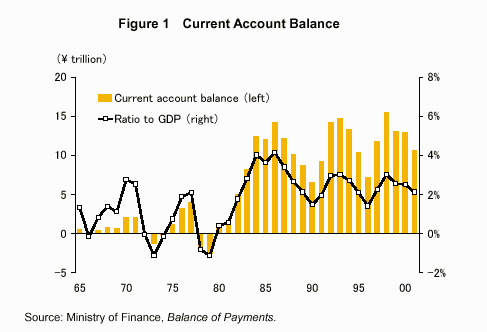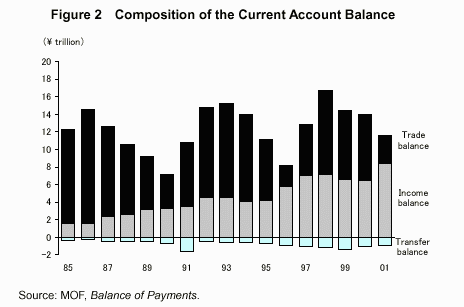- NLI Research Institute >
- The Changing Structure of Japan's Balance of Payments -- Implications of the Shrinking Trade Surplus in Goods and Services
The Changing Structure of Japan's Balance of Payments -- Implications of the Shrinking Trade Surplus in Goods and Services
Koichi Haji
Font size
- S
- M
- L
In the past, Japan's balance of payments has been characterized by a persistent and large trade surplus, with the deficit in services (such as travel, for instance) being eclipsed by a huge merchandise (goods) trade surplus.
However, after reaching 9.5 trillion yen in 1998, the trade surplus plunged for three straight years, dropping to 7.4 trillion yen in 2000, and again by half to 3.2 trillion yen in 2001. Compared to a dip in the services deficit to 5.3 trillion yen, the merchandise trade surplus plummeted to 8.5 trillion yen in 2001 (from 16 trillion in 1998) due to sluggish export growth amid relatively steady import growth. In particular, a flood of imports from China has expanded Japan's bilateral trade deficit with that country to a hefty 3.3 trillion yen.
The most commonly used measure of the balance of payments is the current account balance, which includes the balance of trade in goods and services, net income balance for investment and labor income, and current transfer balance.
Following World War II, as Japan grew internationally competitive and mounted a successful export drive, the current account balance became consistently positive around 1970. Despite a brief period of deficits due to the two oil shocks, the current account remained large and positive from the 1980s, to the point of exacerbating trade friction with Japan's trading partners.
For the world as a whole, the balance of payments is zero by definition, with surpluses in some countries being offset by deficits in others. Whether a particular country is in surplus or deficit does not necessarily indicate that country's economic health. However, since a persistent deficit must be financed with foreign currency reserves or capital inflows from abroad, current account trends are a major concern of international financial markets and economic policymakers.

Despite the 3.2 trillion yen decline in Japan's trade balance in 2001, the current account surplus declined by only 2.2 trillion yen to 10.7 trillion yen mainly because another major component of the current account -- the income surplus -- grew from 6.5 trillion yen to 8.4 trillion yen. The growing size of the income surplus, which now almost rivals the trade surplus, is indicative of major structural changes occurring in Japan's balance of payments.

Koichi Haji
Research field
レポート紹介
-
研究領域
-
経済
-
金融・為替
-
資産運用・資産形成
-
年金
-
社会保障制度
-
保険
-
不動産
-
経営・ビジネス
-
暮らし
-
ジェロントロジー(高齢社会総合研究)
-
医療・介護・健康・ヘルスケア
-
政策提言
-
-
注目テーマ・キーワード
-
統計・指標・重要イベント
-
媒体
- アクセスランキング

















